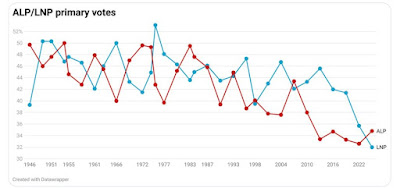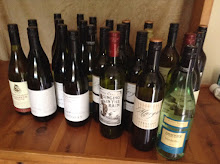Voting is compulsory.
Voting was for the entire House of Representatives (lower house) 150 seats, and one half of the Senate’s (upper house) state representatives and all four territory representatives.
The Senate is a state house of review with state Senators enjoying a six year tenure and territory representatives’ tenure tied to the term of the lower house.
There are a total of 76 senators: twelve are elected from each of the six states regardless of population, and two each from the two territories.
The main contenders for government were the current incumbents, the Australian Labor Party (democratic socialists) and the opposition Liberal National Party (a coalition of urban and rural conservatives*).
There were also a large number of minor parties (30!) eg. The Greens, One Nation plus others and Independents contesting.
It is interesting note how Australia has voted ideologically since 1946.
This time around it was a landslide victory for the Labor Party led by Prime Minister Anthony Albanese.
They won an increased number of seats.
 |
| PM Anthony Albanese |
The conservatives have been decimated.
The LNP opposition leader, Peter Dutton lost the seat he had held for 24 years.
Up until early March polls showed a certain LNP victory.
What happened?
Prior to the 2024 USA election, 73% of Australians surveyed preferred a Democrat presidential victory.
When the USA imposed tariffs on Australian imports despite a trade balance in the former’s favour in April our Prime Minister labelled the US actions as ‘unwarranted’, and ‘not the act of a friend’.
The majority of the population agreed with him.
However Dutton said that if elected he would cut public sector jobs - more than 40,000 by some estimates. This reminded voters of billionaire Elon Musk's DOGE, or Department of Government Efficiency, which has slashed US bureaucracy.
Dutton later walked back the plan but it was too late.
The Coalition even appointed a shadow minister for government efficiency. And images of her wearing a cap with the words MAGA became a key talking point.
Dutton also said Donald Trump is a "big thinker and a deal maker" with a "genuine desire to see peace and stability" in the Middle East after Trump had proposed to "level" the enclave and rebuild a "riviera" under American control.
Shadow attorney-general Michaelia Cash praised Trump as “a man of action”, promising Australians “they’ll get the exact same attitude under a Peter Dutton government”.
Chris LaCivita, Trump’s presidential campaign co-manager, told undercover reporters he advised on ‘structural issues’ related to Peter Dutton.
However the Coalition denied LaCivita was involved in campaign in any way.
But there were other major factors as well.
The Coalition’s nuclear energy policy was toxic to voters, delivering big swings against their candidates in electorates chosen to host reactors, while support for Labor grew in many places it chose for massive offshore wind farms.
It was hoped the LNP would tailor some policies towards women. It was clear it wasn’t a priority.
The policy and messaging on work from home and the failure to acknowledge how hard women’s lives already are, without lumping them with more, was nothing short of disgraceful.
It brazenly highlighted that the party was still disconnected from the everyday lives of women.
Housing affordability has long been a priority issue for voters at federal elections, but as the “great Australian dream” of homeownership slips out of reach, both sides amplified their property policies.
Most economists were cynical about the measures, saying these will simply increase demand for housing in a market where the supply of new homes is constrained because of government regulation and the high cost of construction.
The expected result of both party policies?
Higher house prices and more risky debt levels.
The LNP went to the election with an economic policy of tax rises and two years of bigger budget deficits, built on a guarantee that the economy would instantly improve merely because they would running the show.
Most voters treated this flimsy assertion as a joke.
On defence, it pledged to spend more but could not nominate on what.
The cost of living crises was met with similar shady policies.
In the final weeks of the campaign, the opposition doubled down on stoking fear and division, reviving culture-war rhetoric, attacking diversity initiatives, and once again turning Aboriginal people into political targets.
And of course there was Dutton himself.
The opposition leader was well known for his "tough guy" persona, developed off the back of years as a police officer and later as immigration and home affairs minister.
 |
| Peter Dutton |
In the end it was all more than the electorate could bear and it responded accordingly.
Nearly five million Senate ballot papers have been received at state-based Central Senate Scrutiny sites now and this is where the process of capturing and validating the hundreds of millions of Senate preferences occurs.
While some Senate positions are known now, the full Senate count is always a reasonably lengthy process with final positions not known until the full distribution of preferences some weeks after election day.
A total of 39 votes is needed to pass laws in the Senate, meaning Labor can ensure passage of bills with the support of just the Greens or the Coalition.
Nationals leader David Littleproud has sensationally announced that his party has split with the Liberal Party for the next term of federal parliament.
Littleproud spoke in Canberra on Tuesday morning after he and new Liberal leader Sussan Ley held discussions over the past week to try to come to terms, but were unable to do so.
The Liberal and National parties are inching towards reforming the Coalition after Liberal MPs gave their leader Sussan Ley in-principle agreement for most of David Littleproud’s policy demands, but speculation is growing about Littleproud’s future as leader of the regional party. Ley convened a party room meeting on Friday afternoon at which her MPs gave their leader the authority to strike a deal with the Nationals to create a joint shadow cabinet
by the time parliament resumes, days after Littleproud sparked chaos by splitting from the Liberals.
Update: 28/05/2025: Liberal and National Parties Reunite.
The Coalition is officially back together after Liberal leader Sussan Ley and Nationals leader David Littleproud struck an agreement to reunite. They both have announced their combined shadow ministry.
What a circus!
Update 10/06/2025: Battle for the Last Seat
Teal candidate Nicolette Boele has seized the once blue-ribbon north shore seat of Bradfield after a recount, beating Liberal hopeful Gisele Kapterian by just 26 votes in one of the tightest elections in history.
Boele’s win will mark the first time in 75 years that the seat is not held by the Liberals but despite the Australian Electoral Commission declaring Boele the winner, Kapterian has not conceded and has indicated she would consider taking the result to court. The Liberal Party’s NSW branch will have until 40 days after the Australian Electoral Commission (AEC) returns the writs to do this ie.before 9th July.




















